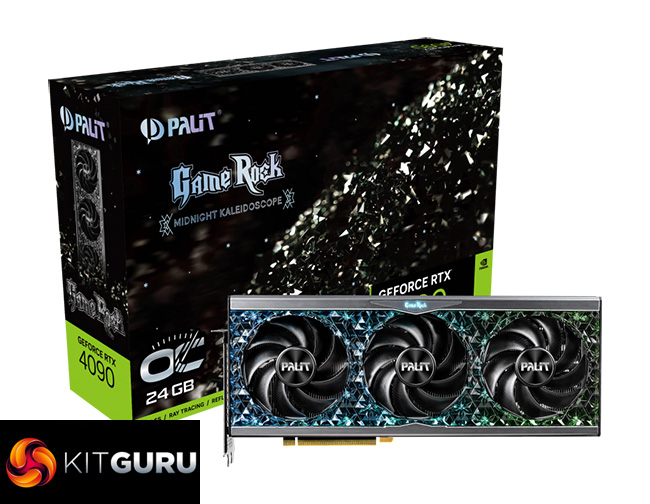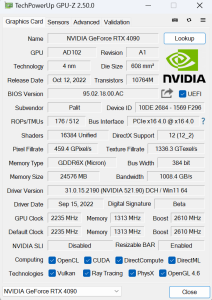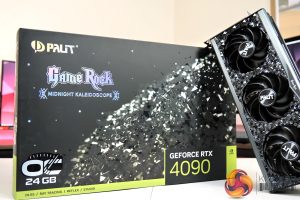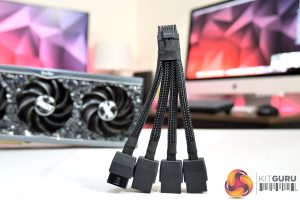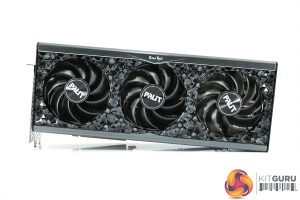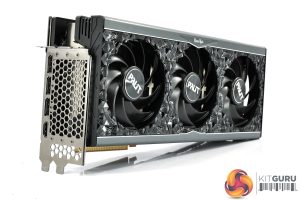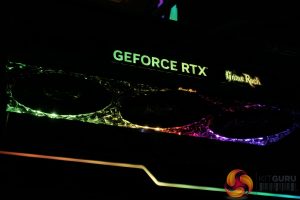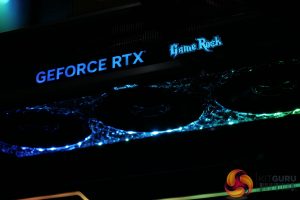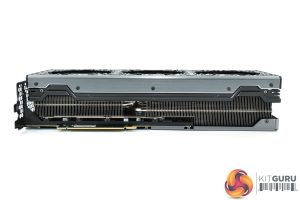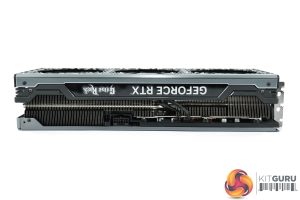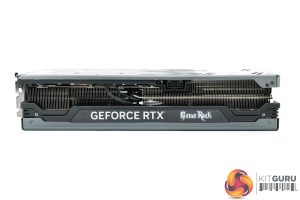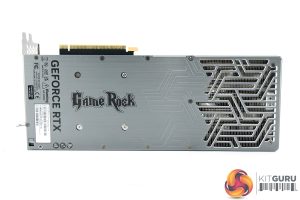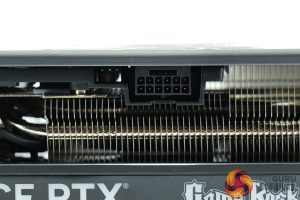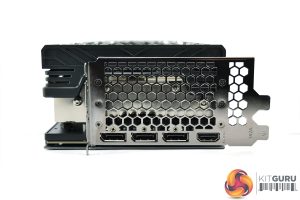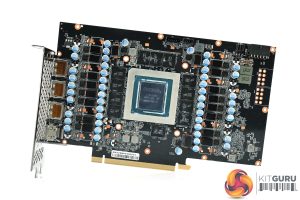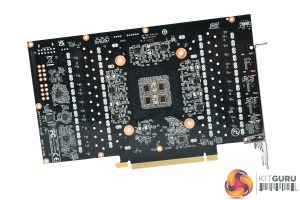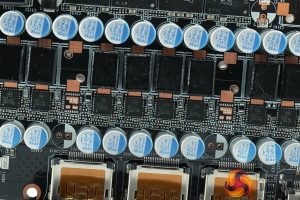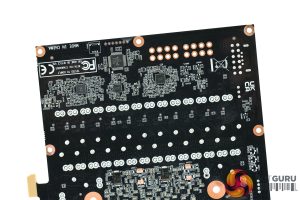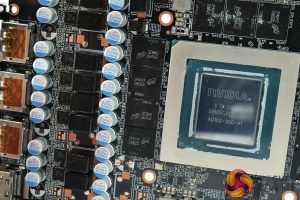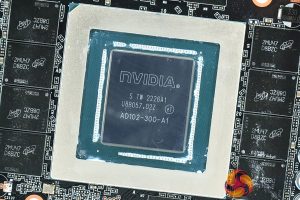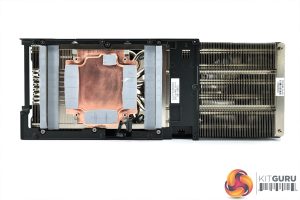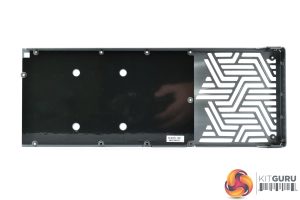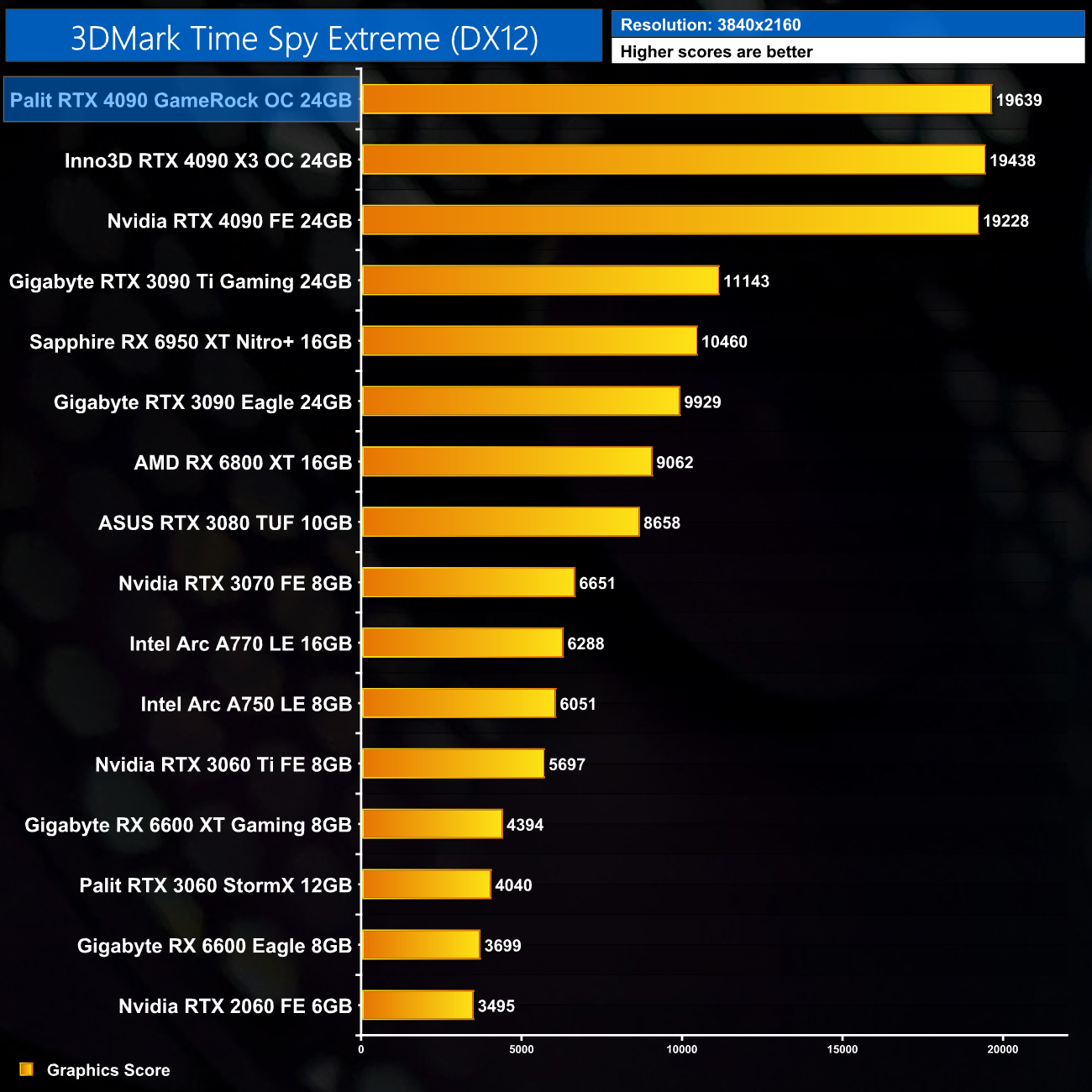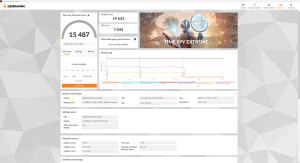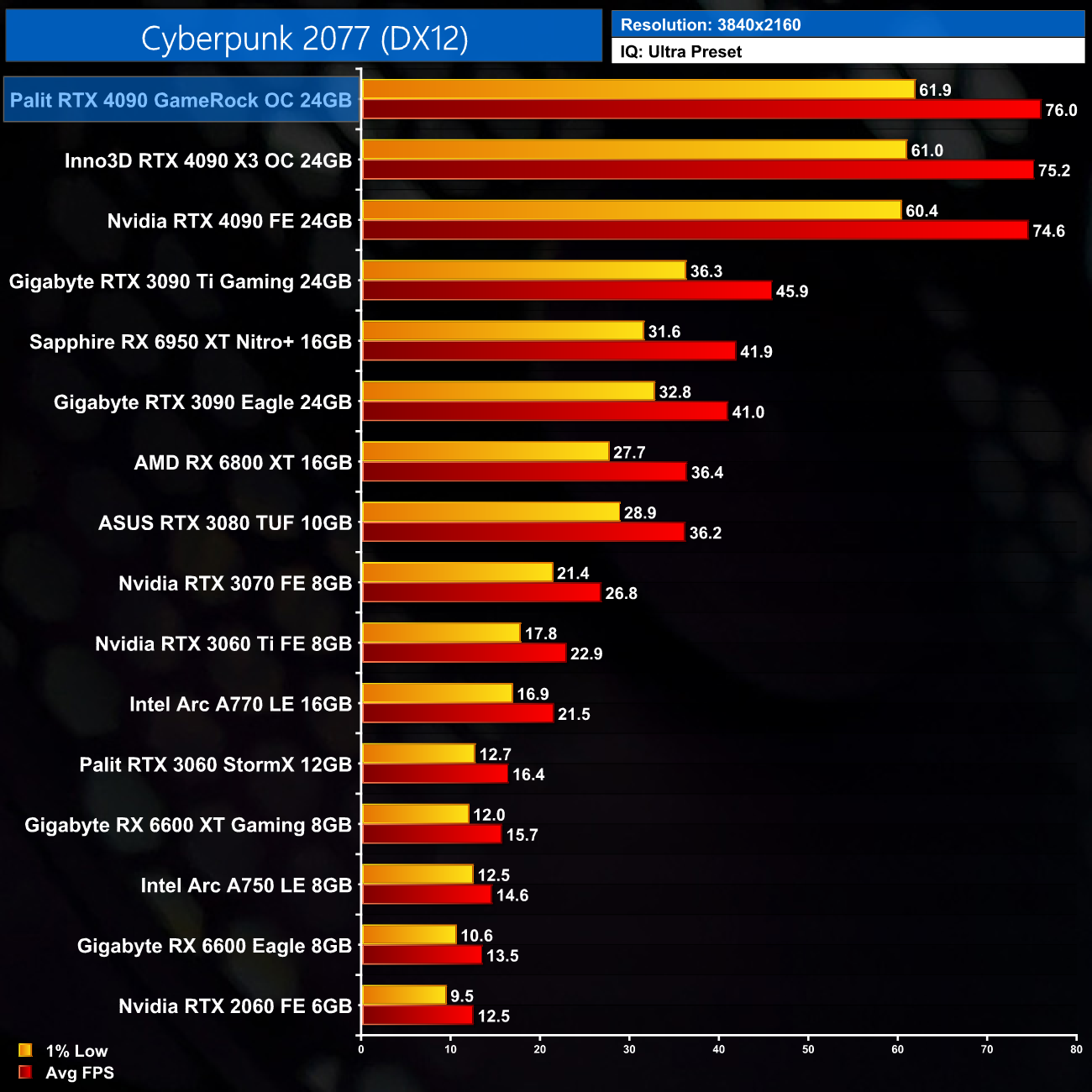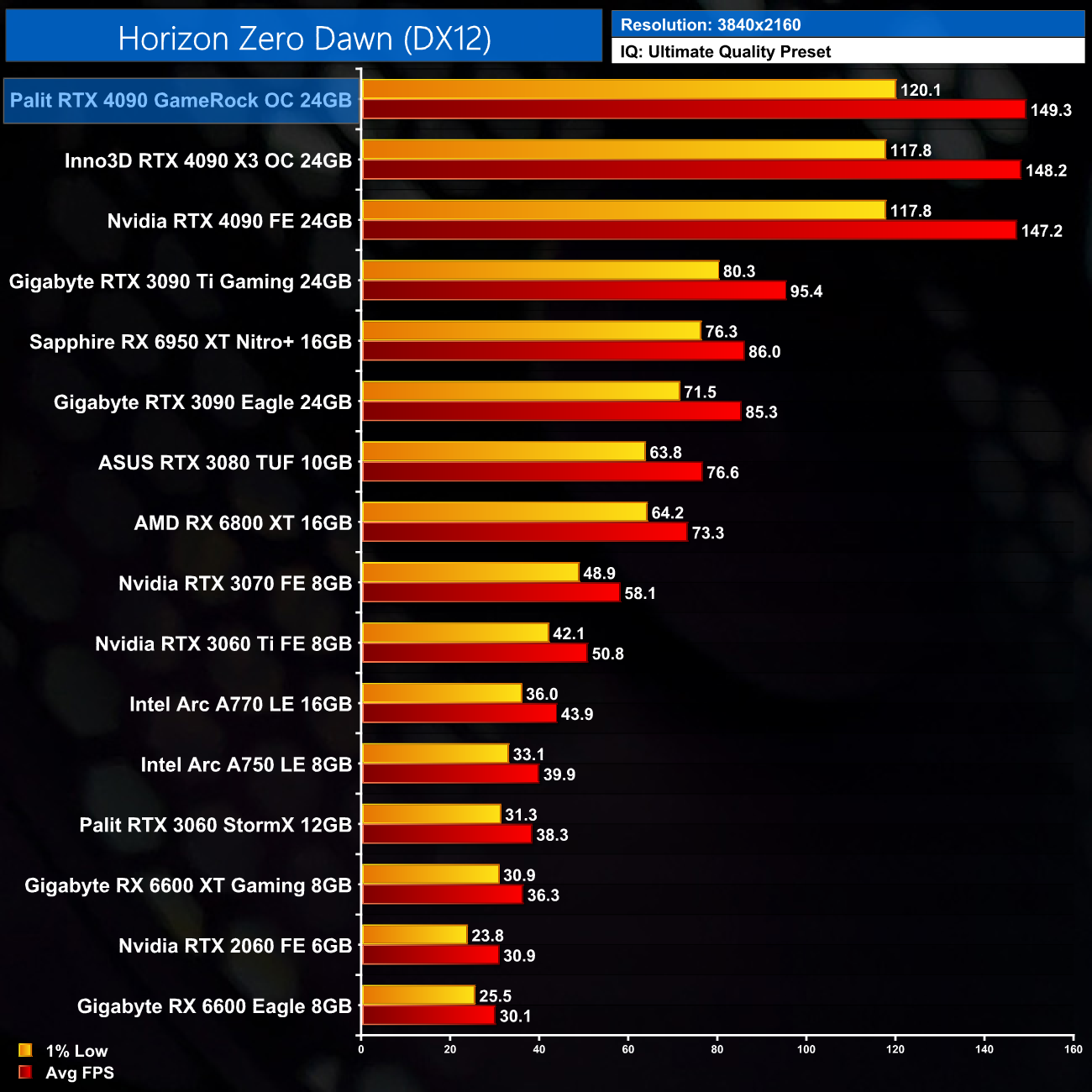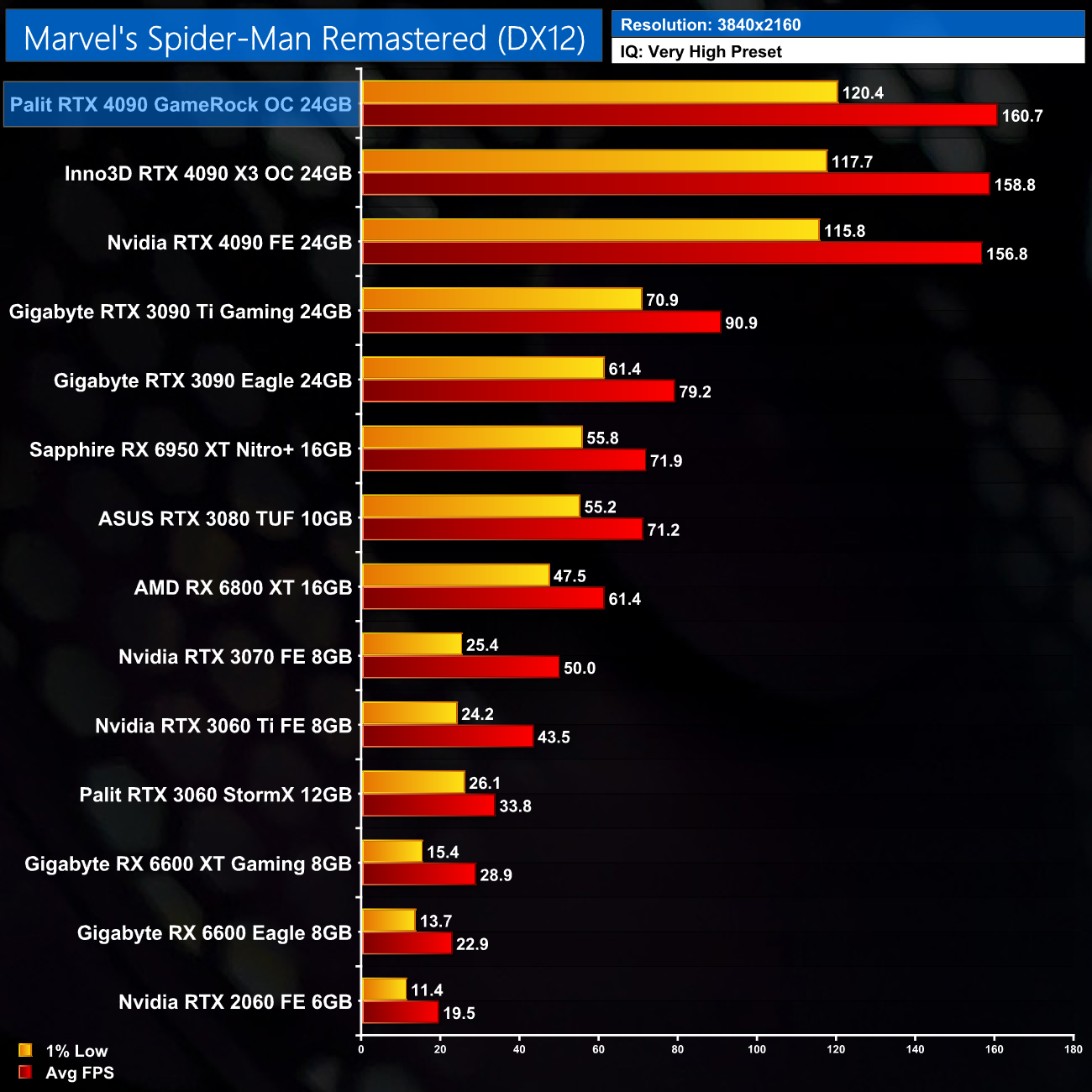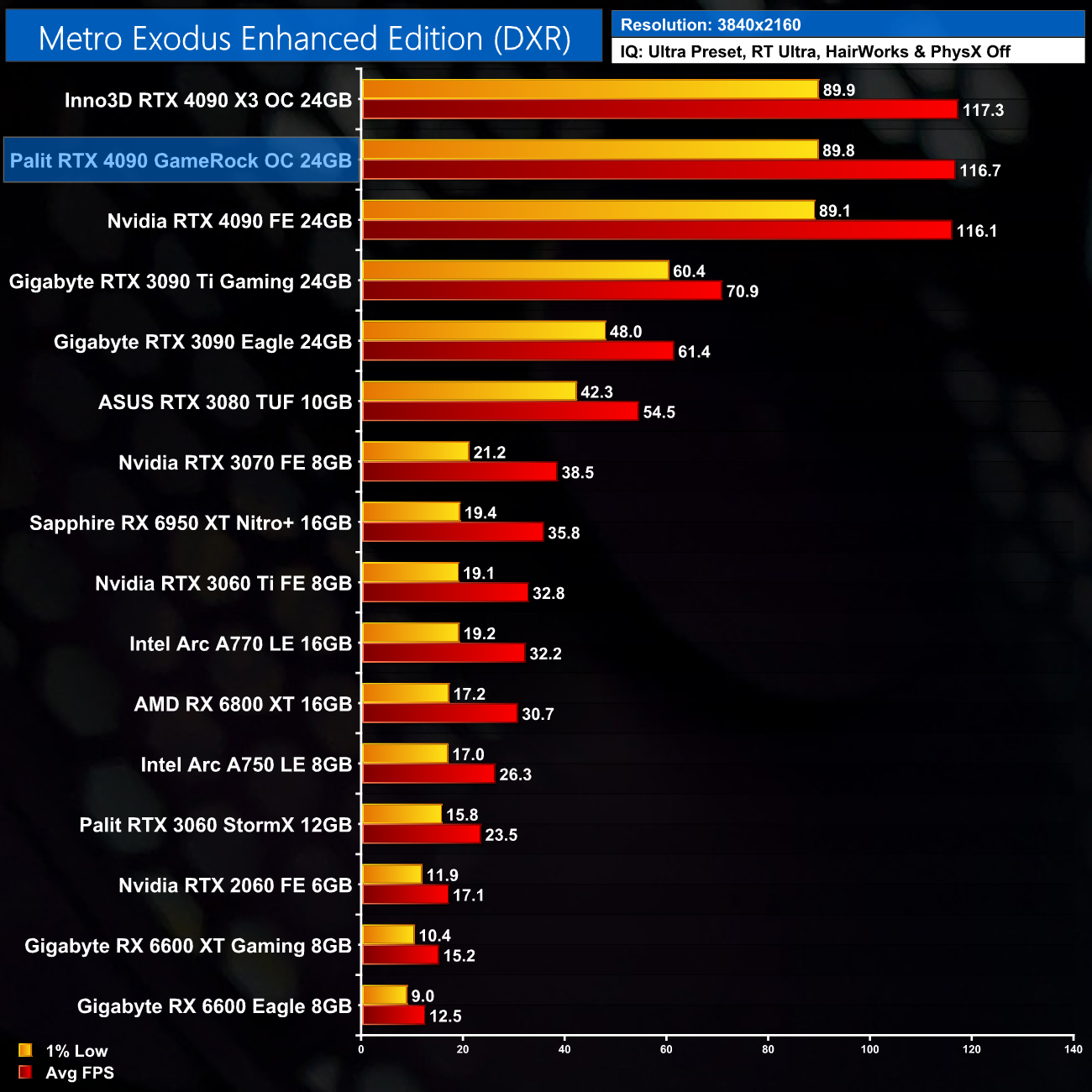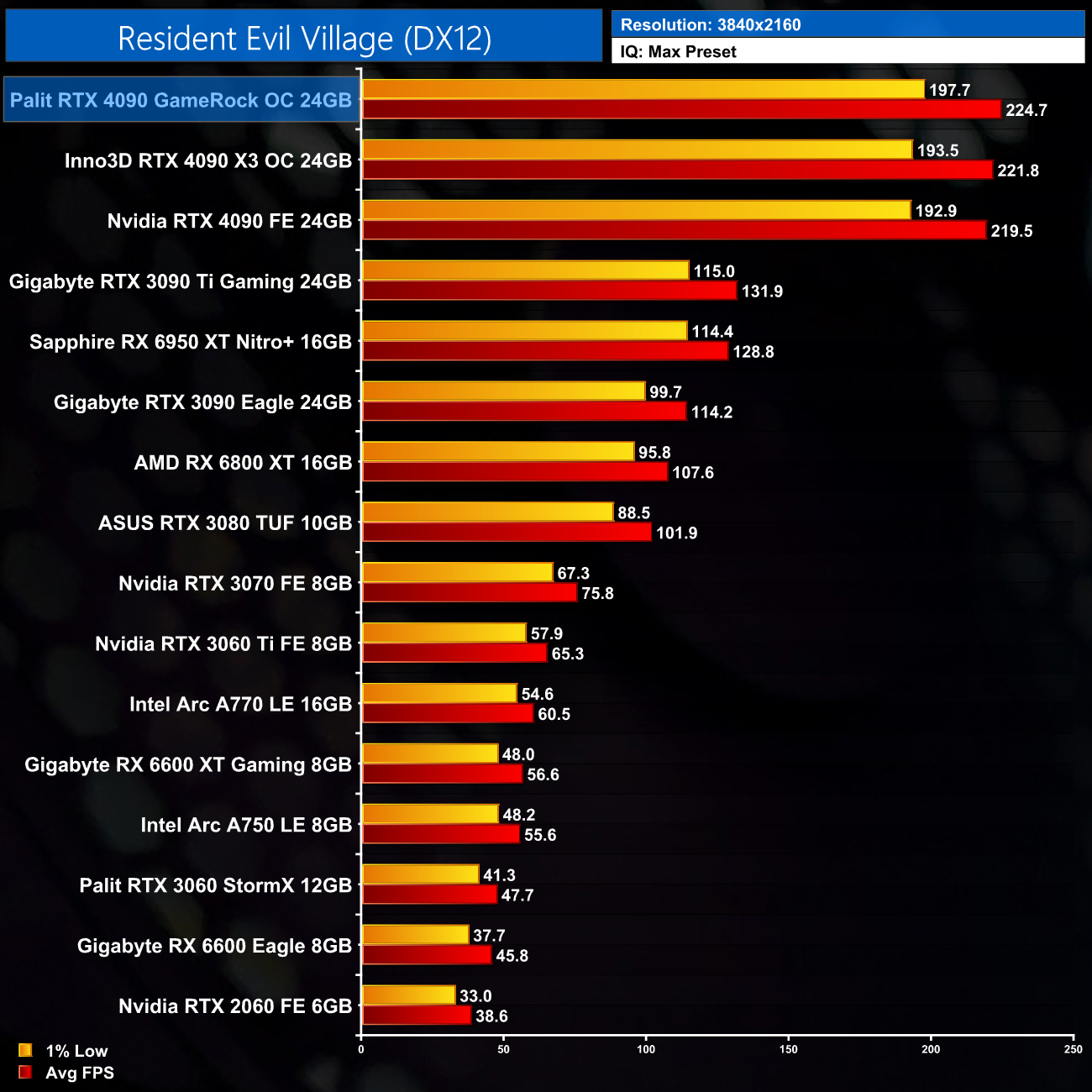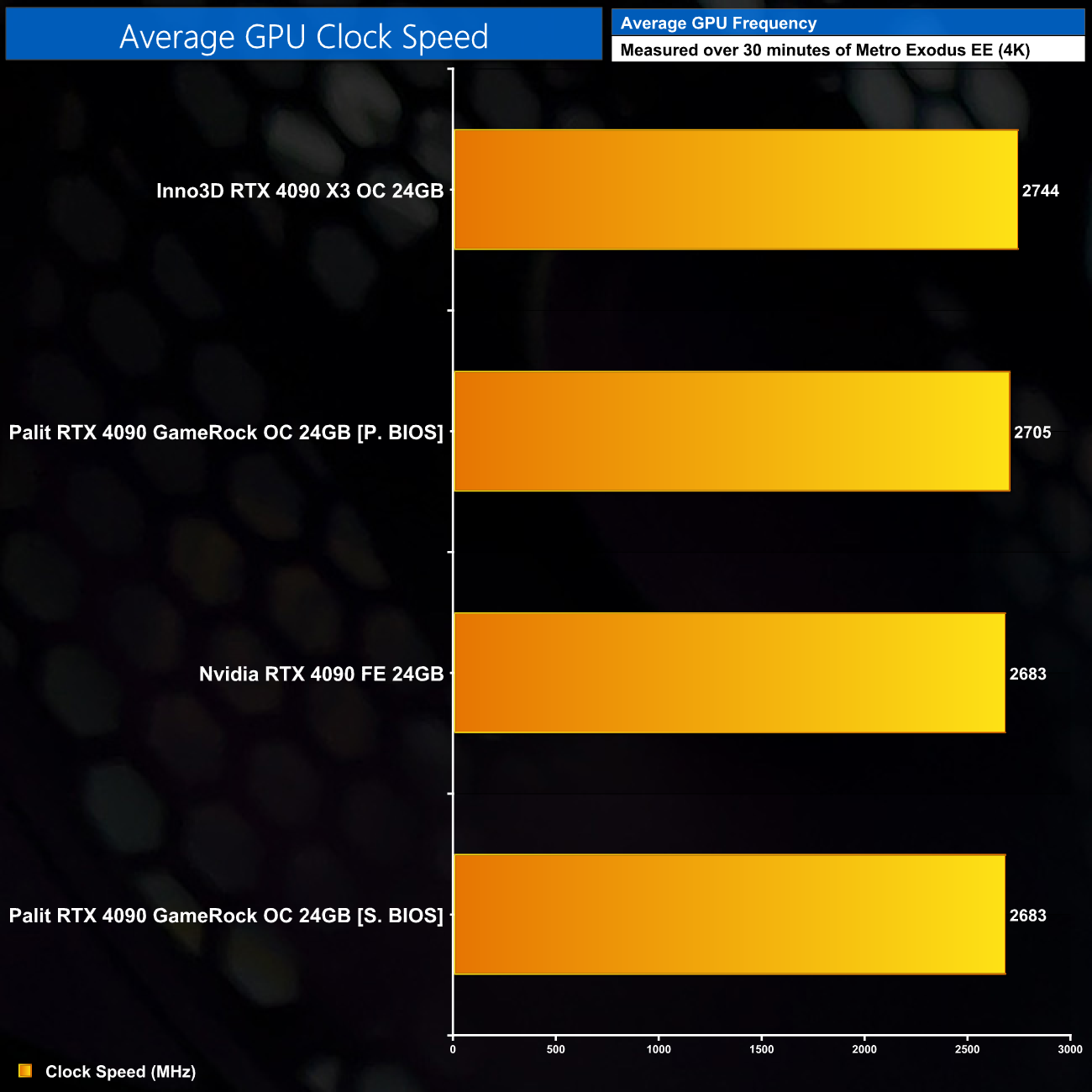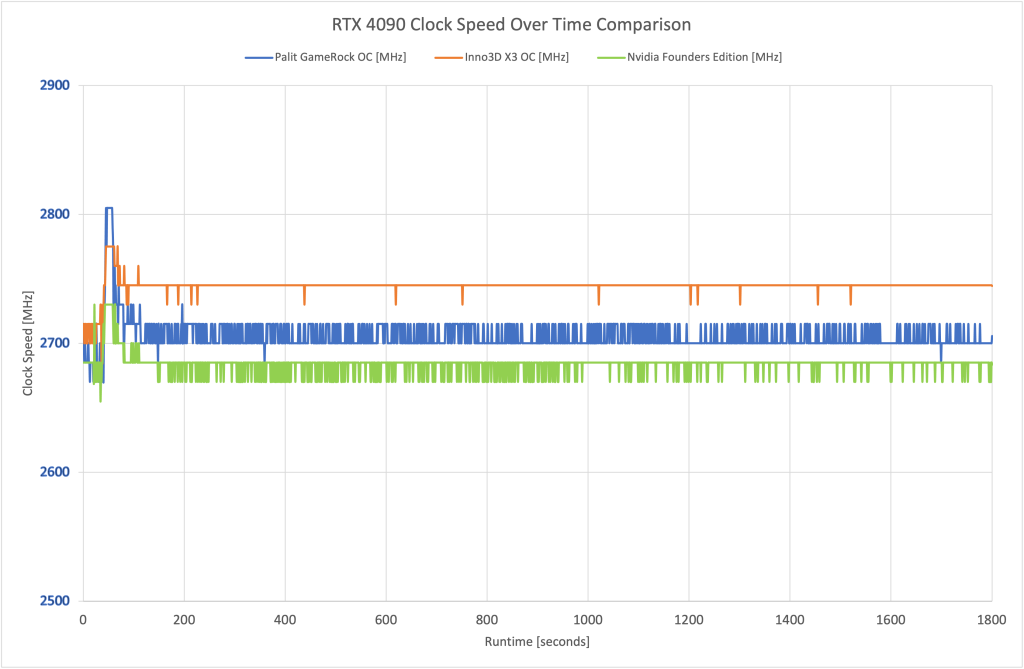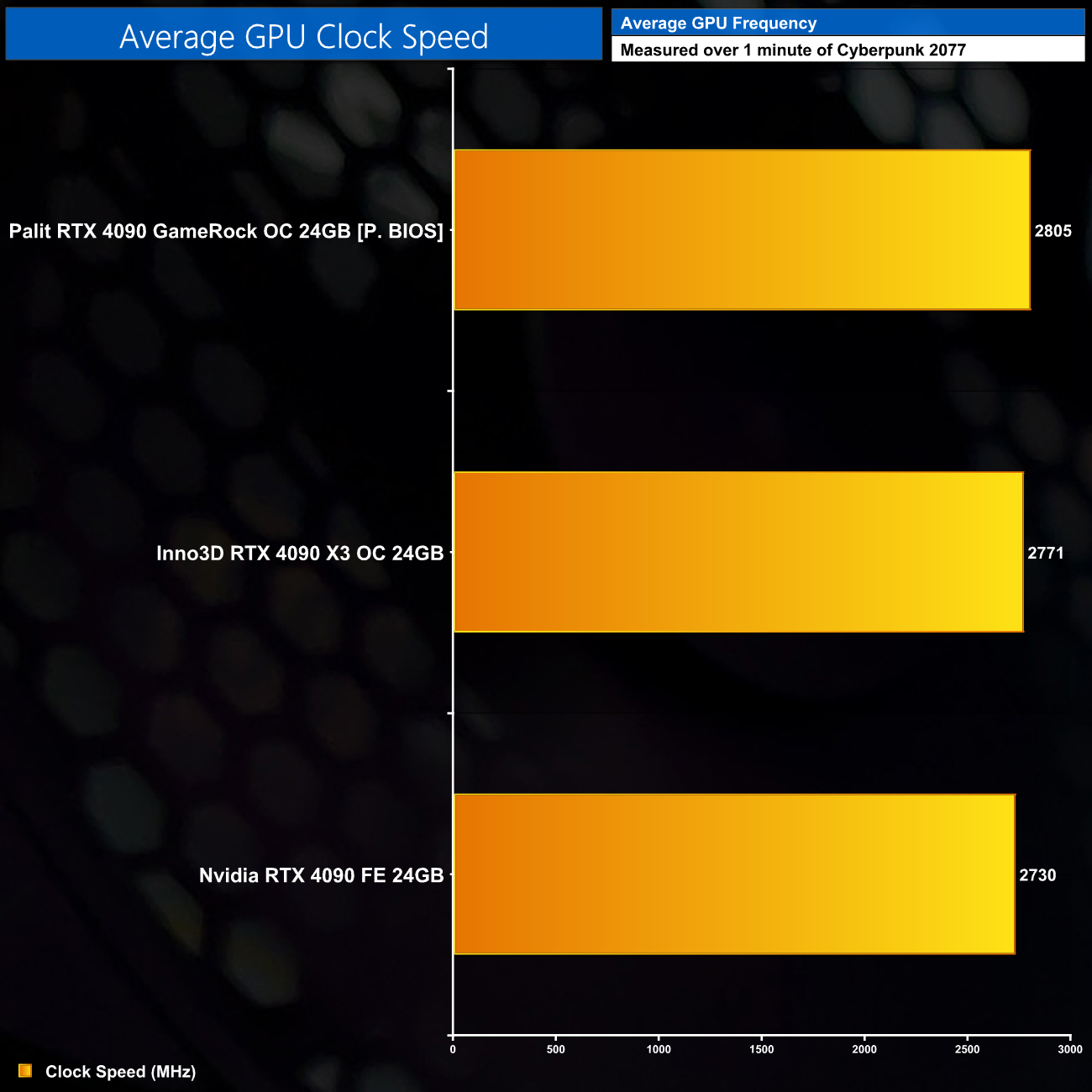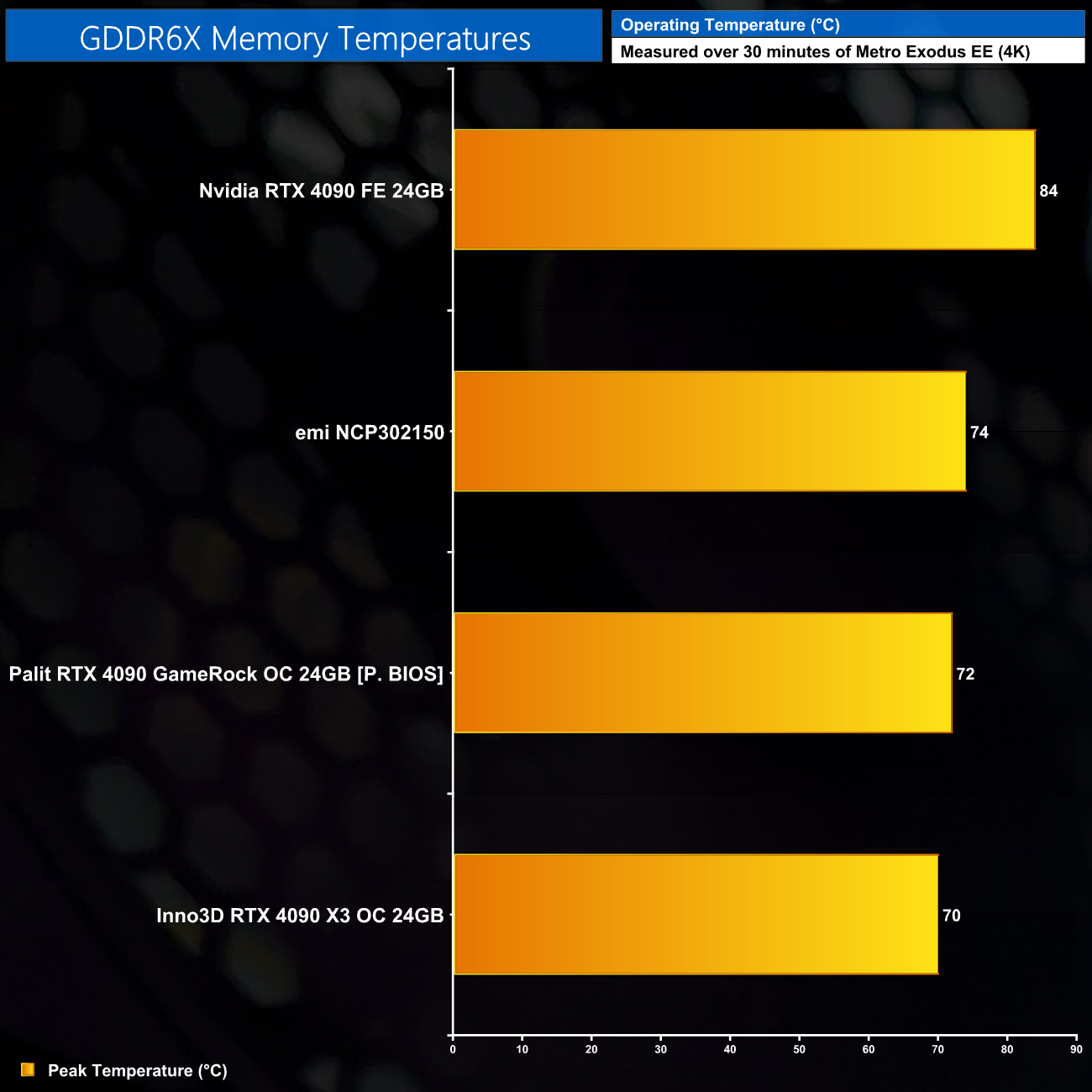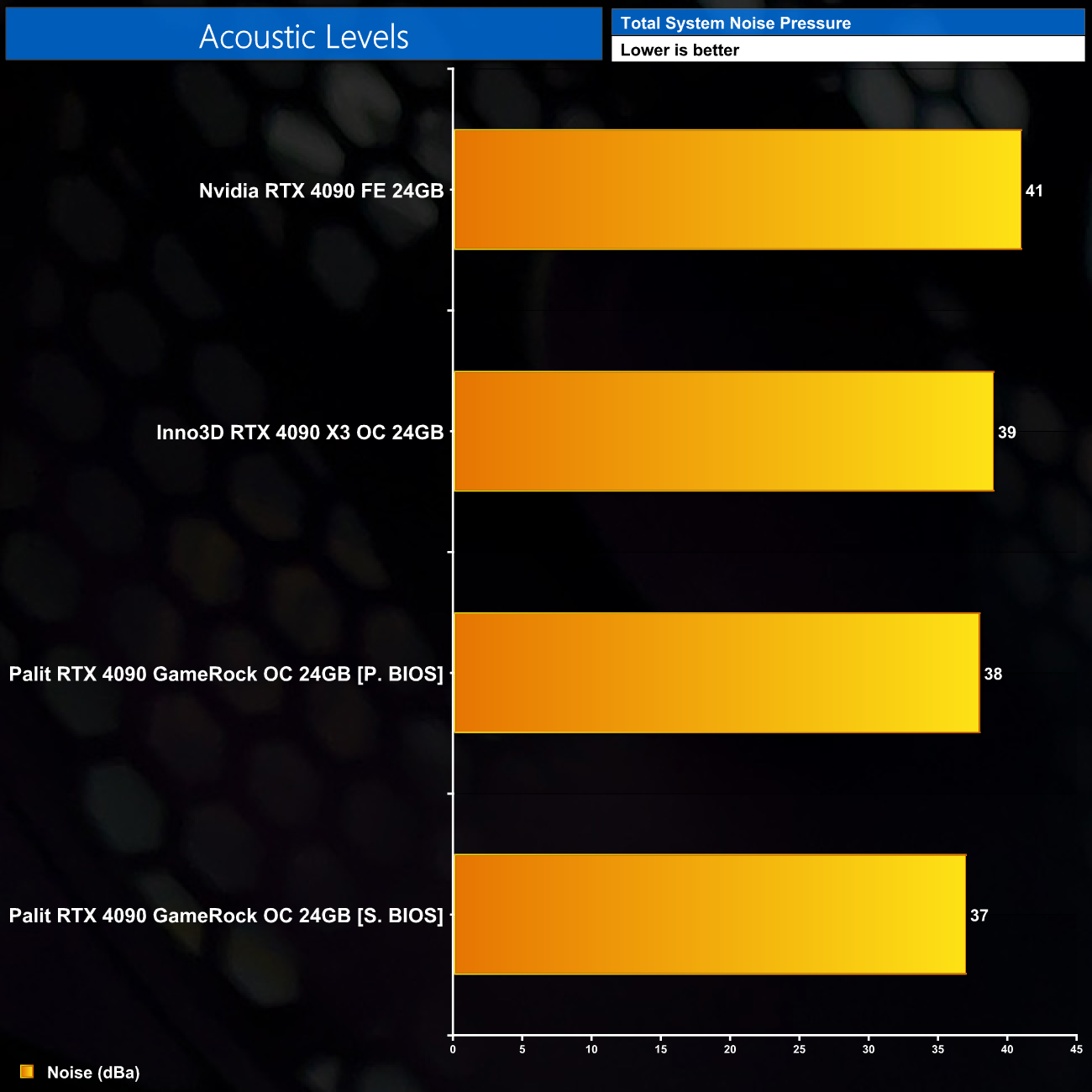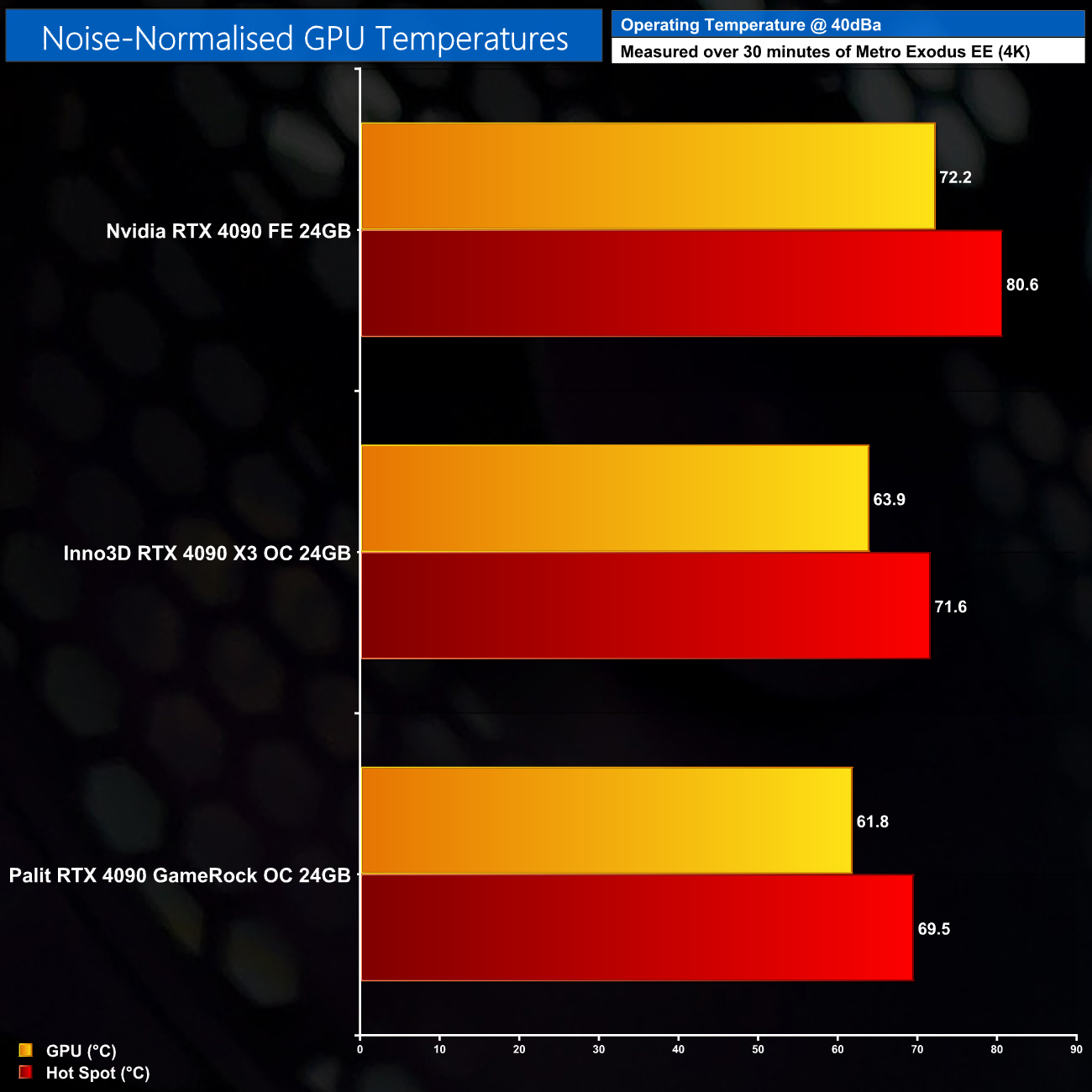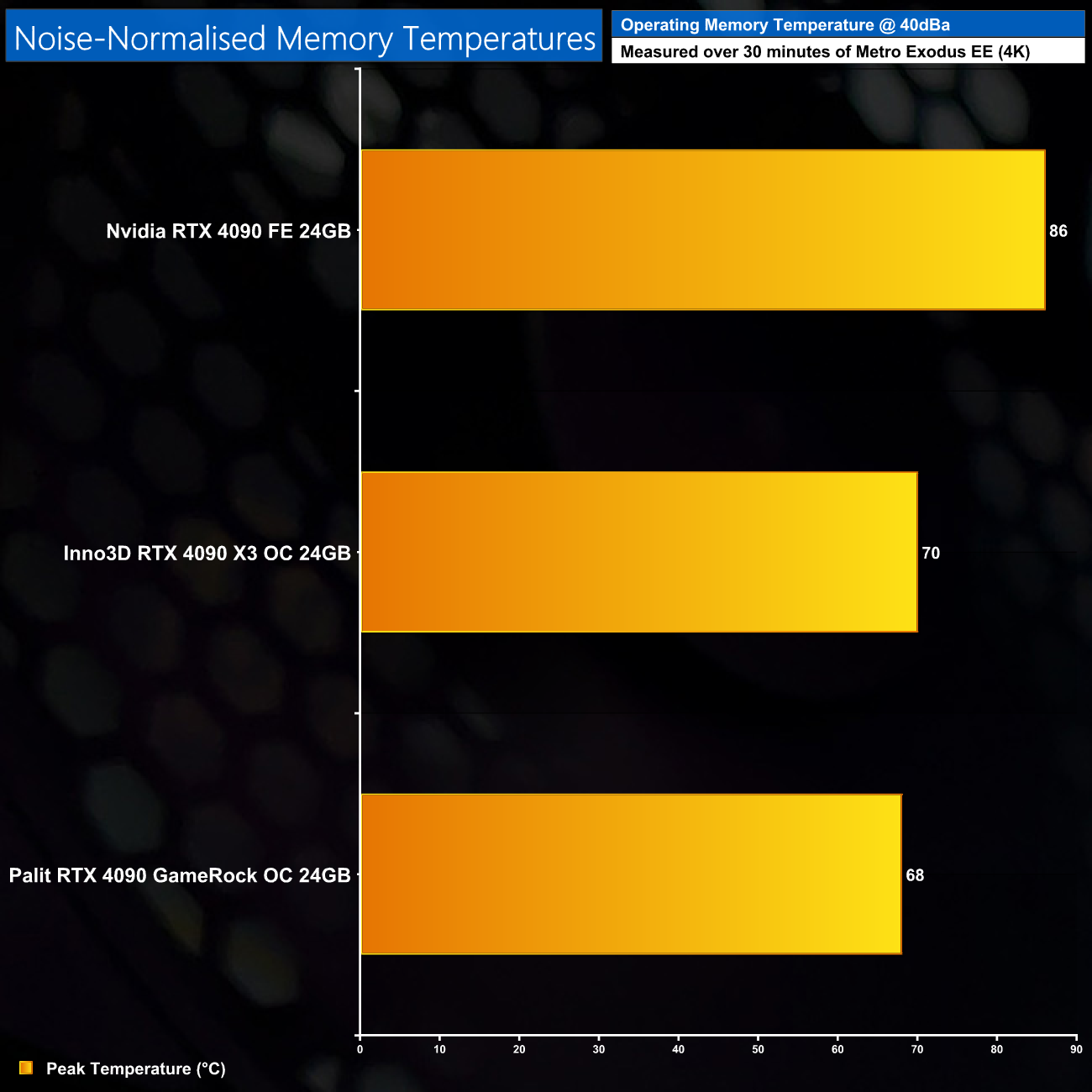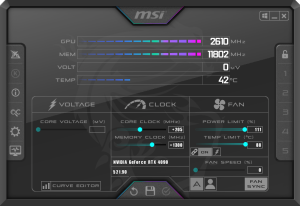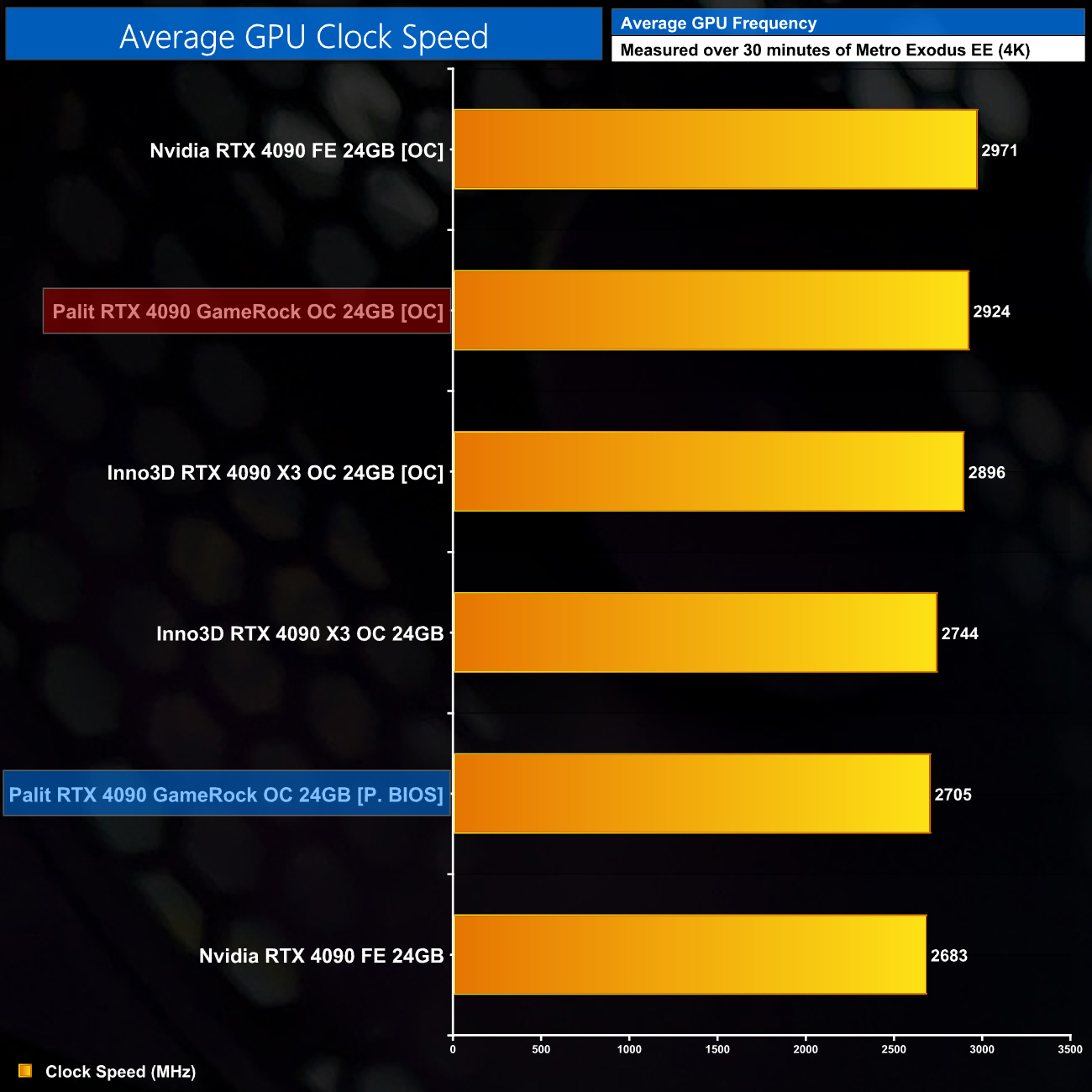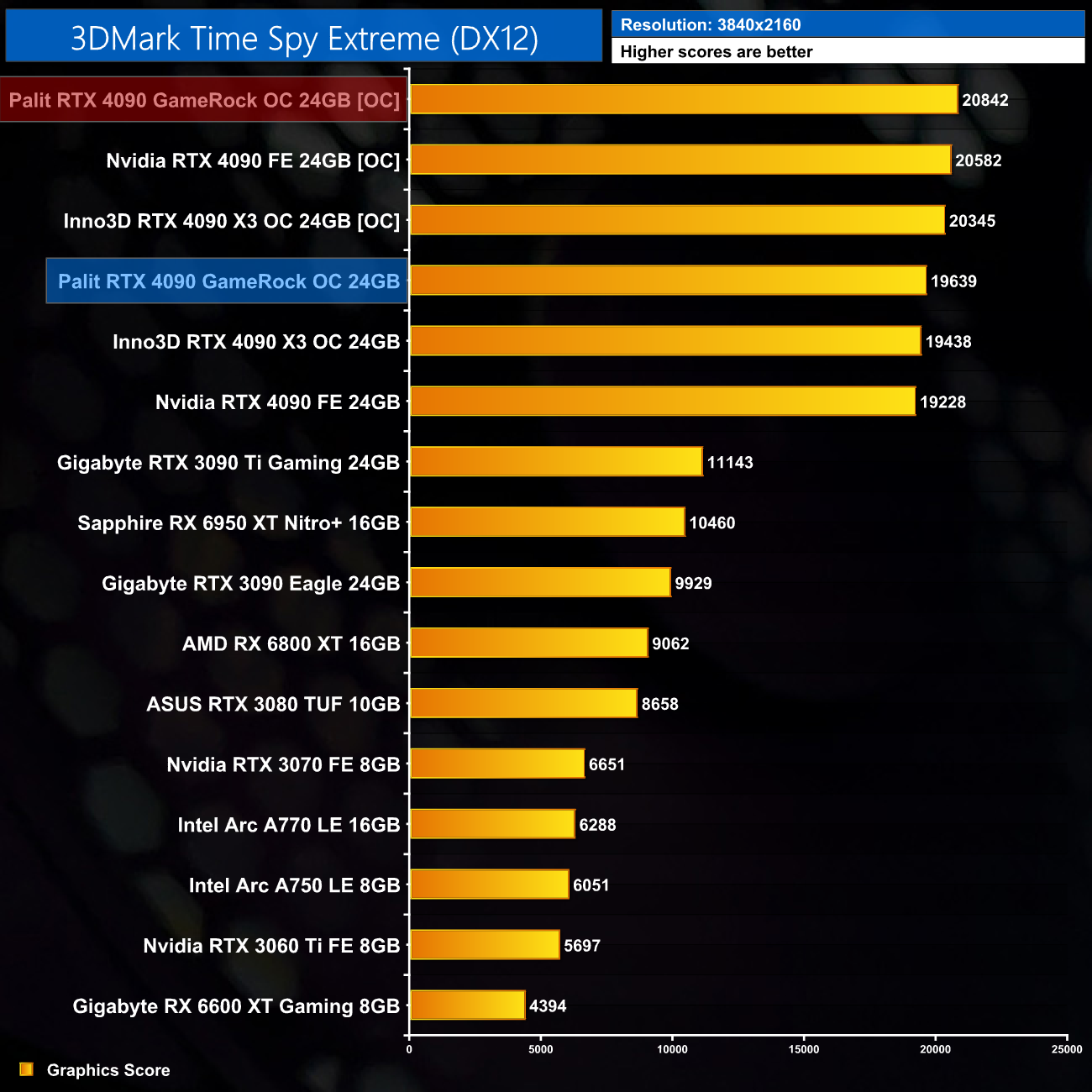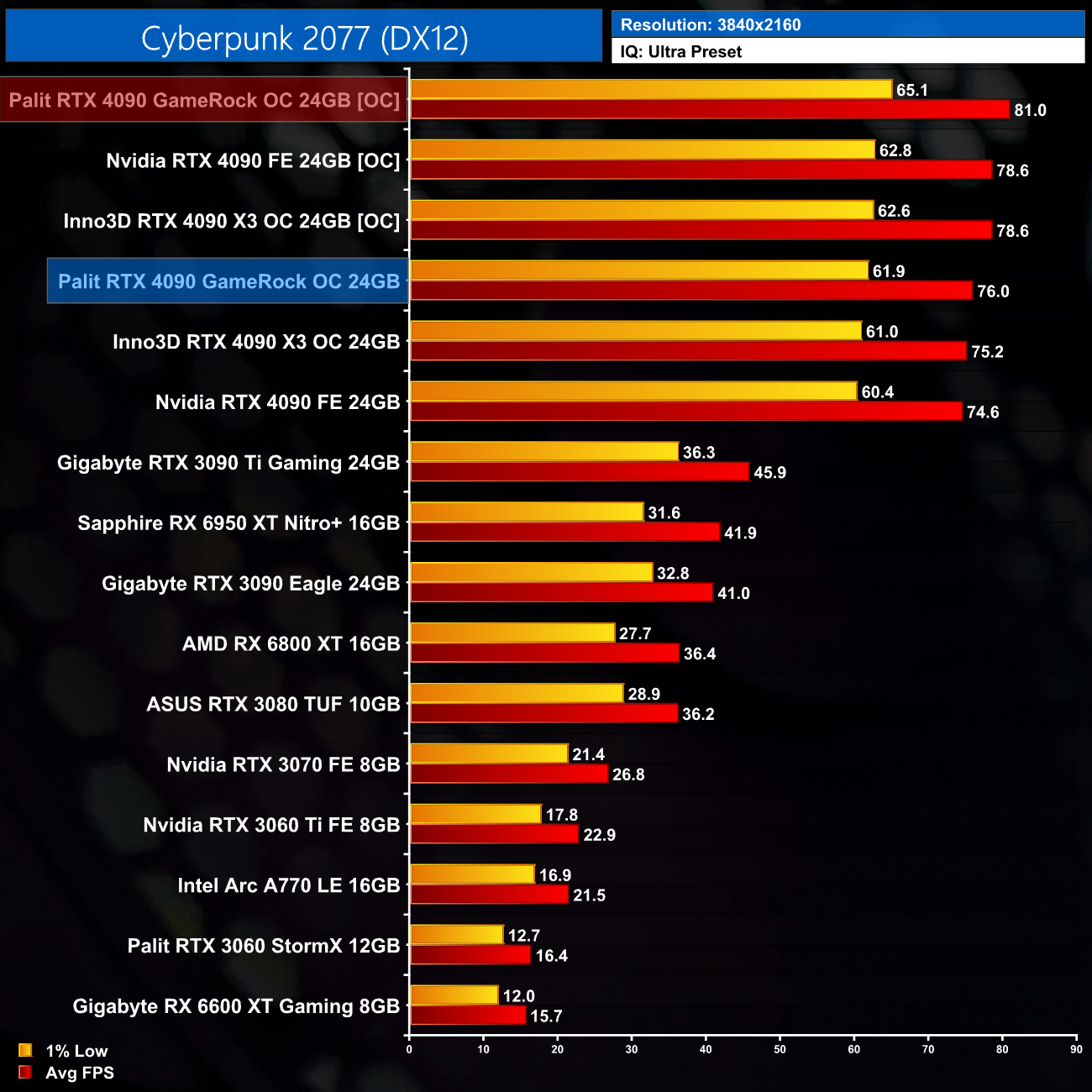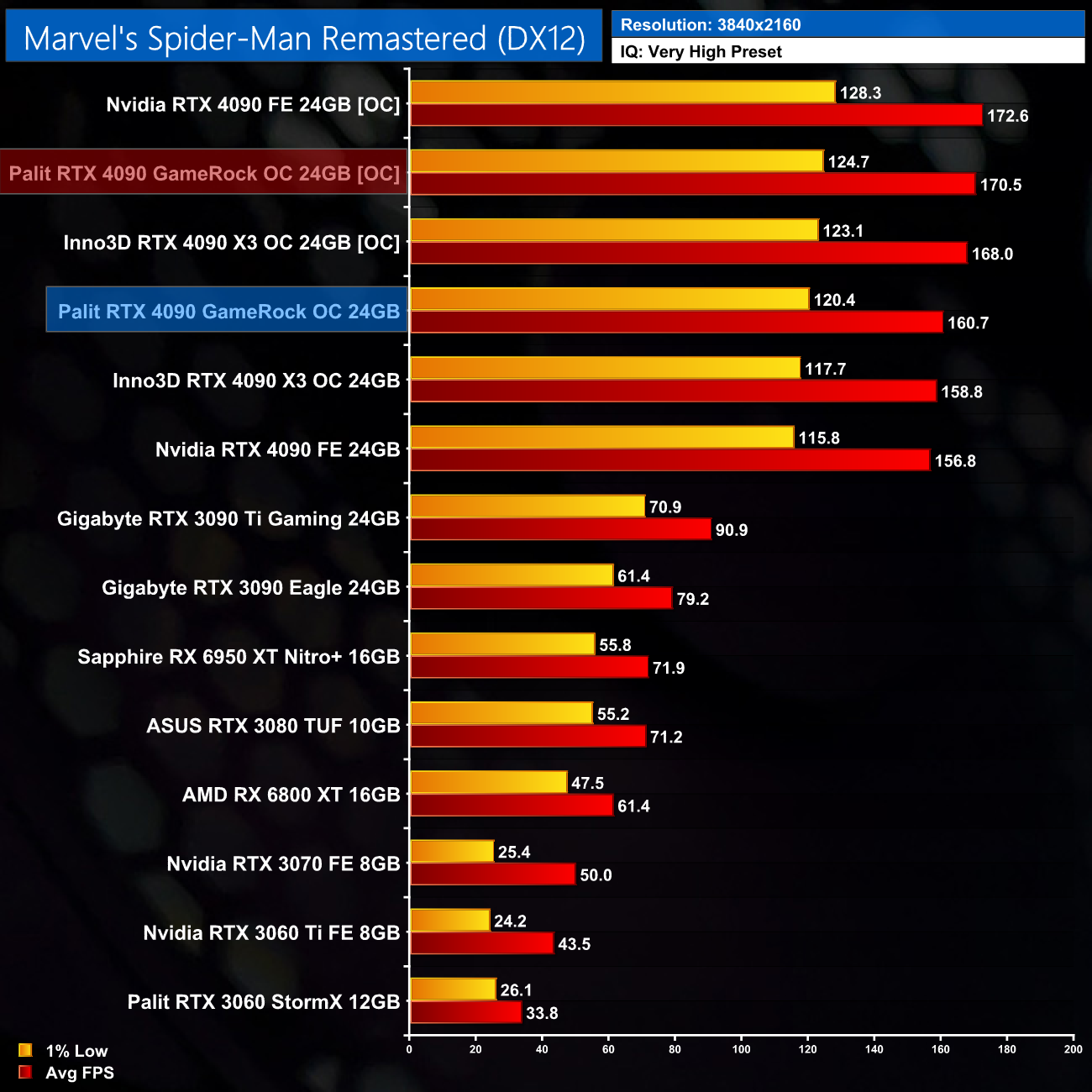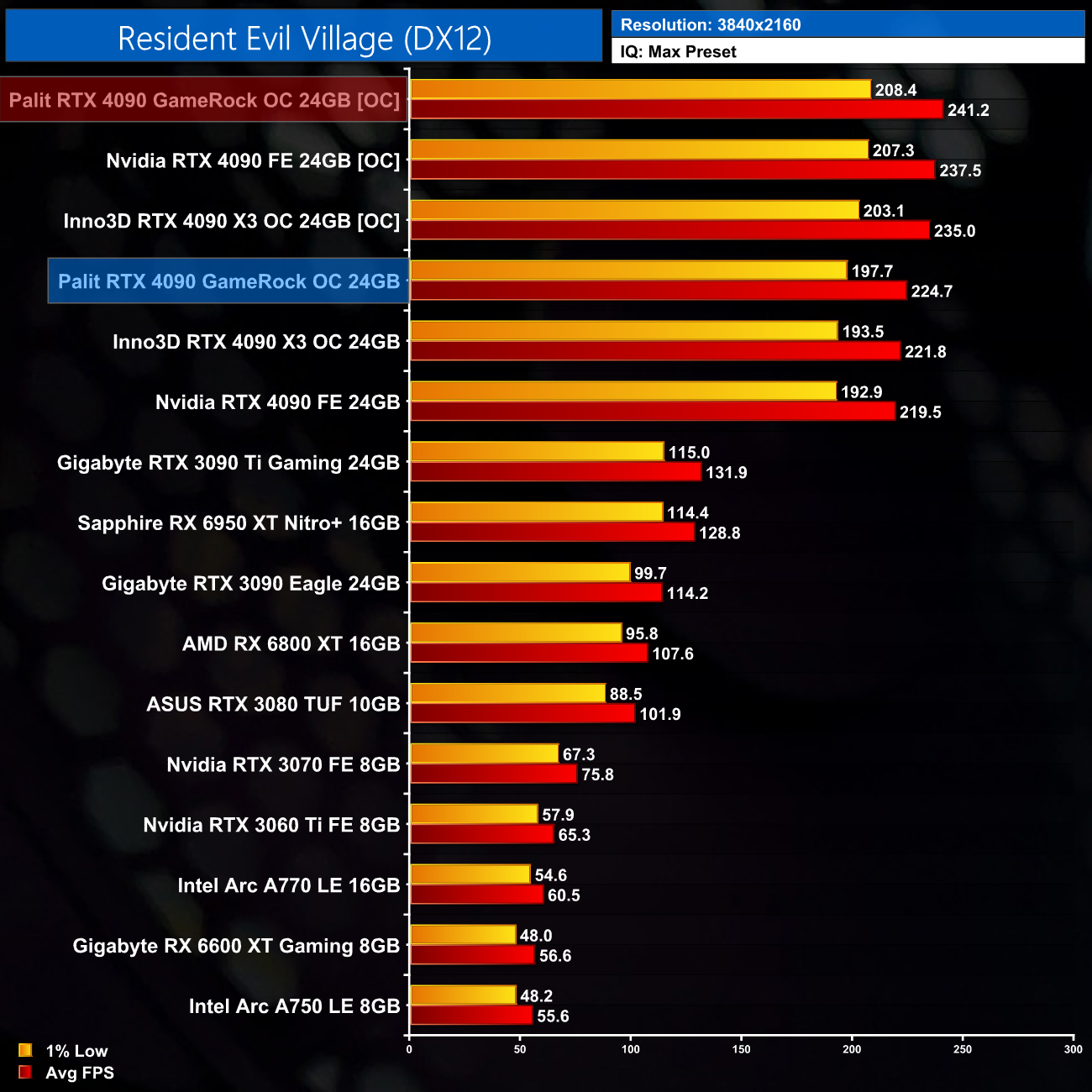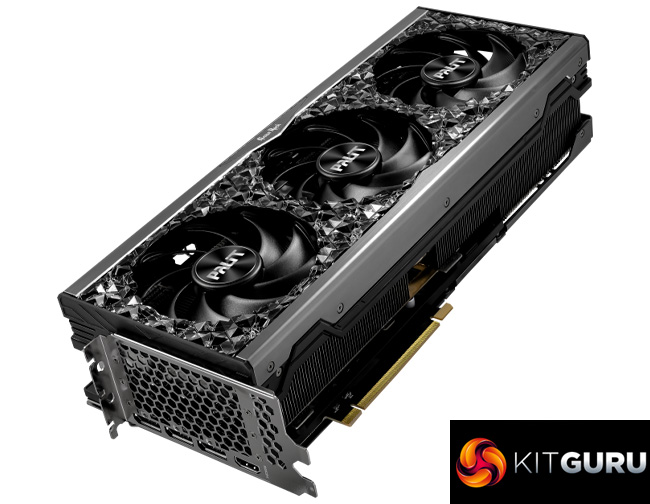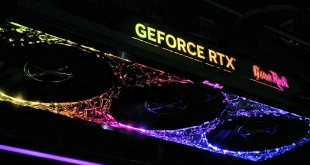
Today we follow up our initial RTX 4090 coverage with another AIB card review. This time we are assessing the Palit RTX 4090 GameRock OC, dubbed ‘Midnight Kaleidoscope' due to the new design. It's still packing an eye-catching amount of RGB lighting, dual-BIOS and a triple-slot cooler, so let's see what this card can do as we compare it against the Nvidia Founders Edition and Inno3D X3 OC.
While the Palit RTX 4090 GameRock OC may not look radically different from the GameRock cards of the 30-series, it has undergone a few changes, including a tweaked colourway, new fan design, and updated heatsink.
Factor in the dual-BIOS, with the performance mode that allows the power limit to be pushed up to 500W, and on paper, the GameRock OC looks like a very appealing card if you're in the market for an RTX 4090. We put it through its paces today…
| RTX 4090 | RTX 3090 Ti | RTX 3090 | RTX 3080 Ti | RTX 3080 | |
| Process | TSMC 4N | Samsung 8N | Samsung 8N | Samsung 8N | Samsung 8N |
| SMs | 128 | 84 | 82 | 80 | 68 |
| CUDA Cores | 16384 | 10752 | 10496 | 10240 | 8704 |
| Tensor Cores | 512 | 336 | 328 | 320 | 272 |
| RT Cores | 128 | 84 | 82 | 80 | 68 |
| Texture Units | 512 | 336 | 328 | 320 | 272 |
| ROPs | 176 | 112 | 112 | 112 | 96 |
| GPU Boost Clock | 2520 MHz | 1860 MHz | 1695 MHz | 1665 MHz | 1710 MHz |
| Memory Data Rate | 21 Gbps | 21 Gbps | 19.5 Gbps | 19 Gbps | 19 Gbps |
| L2 Cache | 73728 KB | 6144 KB | 6144 KB | 6144 KB | 5120 KB |
| Total Video Memory | 24GB GDDR6X | 24GB GDDR6X | 24GB GDDR6X | 12GB GDDR6X | 10GB GDDR6X |
| Memory Interface | 384-bit | 384-bit | 384-bit | 384-bit | 320-bit |
| Memory Bandwidth | 1008 GB/Sec | 1008 GB/Sec | 936 GB/Sec | 912 GB/Sec | 760 GB/Sec |
| TGP | 450W | 450W | 350W | 350W | 320W |
First, for a quick spec recap. Fabbed on TSMC's 4nm node has allowed Nvidia to vastly increase transistor count, up from 28.3 billion with GA102, to a staggering 76.3 billion with the largest Ada GPU, AD102. Accordingly, core count has gone through the roof, with the RTX 4090 home to 16384 CUDA cores, with 512 Tensor cores and 128 RT cores, with a sizeable increase to the ROP count too, up to 176.
Such a leap forward in process node has also allowed Nvidia to crank the clock speed significantly, with the RTX 4090 now sporting a 2520MHz rated boost clock. The Palit GameRock OC we are reviewing today has tweaked that further, adding an extra 90MHz out of the box.
Memory configuration is almost identical to the RTX 3090 Ti, with 24GB GDDR6X running at 21Gbps, operating over a 384-bit interface, totalling memory bandwidth of just over 1TB/s. That said, there has been a substantial upgrade to the L2 cache with the Ada architecture, with the RTX 4090 now offering 73MB, compared to 6MB for GA102.
Power draw also remains at 450W, as per the RTX 3090 Ti, and while this is also the case for the Palit GameRock OC, it can reach up to 500W when overclocking.
The Palit RTX 4090 GameRock OC ships in a glittering black box, featuring the GameRock logo and the ‘midnight kaleidoscope' branding.
Inside, the key accessory is a 4x 8-pin power adapter, while a support bracket is also included to avoid GPU sag (as shown in the video.)
In terms of the overall design of this card itself, it’s certainly similar to the GameRock cards from the 30-series, but Palit has toned things down a bit and gone for a darker overall look, hence the name Midnight Kaleidoscope.
We find a black plastic shroud, though there's two large brushed metal plates that definitely add a premium feel in the hand. Meanwhile, the plastic RGB diffusers that fill the space around the three fans – which Palit call the ‘crystals' – are now a much darker shade as well – until they are turned on, of course!
Palit is also keen to emphasise the new fan design. Each fan measures 90mm so they're a decent size without being massive. These are now called ‘gale hunter' fans, too, with a new ‘winglet fantail' that Palit claims helps to increase airflow concentration.
Speaking of the RGB, there's no denying this is one of the highlights of this card, with a very vibrant and unique aesthetic. It will certainly split opinion, but if you like RGB… you'll love the GameRock.
I do think that to really get the most from the RGB, however, you’d want to vertically mount the card for the most visual impact. I’m not sure that’s the best idea considering how thick the card is though, as it is likely to be pressed right up against the case side panel, potentially choking the air intake.
You can still see a good amount of the lighting though with the card mounted horizontally, and Palit also lets you sync the lighting with your motherboard via an included ARGB cable. The header for this is right in the middle of the card itself though, next to the power connector, and that potentially causes a cable management headache, so I would have preferred to see this header on the end of the card.
We can't ignore the sheer size of this card either – as we’d expect for any RTX 4090, it’s rather large, measuring 329 x 137.5 x 71.5 mm, so it’s actually three and a half slots thick. Palit does include a small support bracket which screws into the end of the card, though it’s not the most robust approach I’ve seen.
Flipping the card over we get a look at the full-length metal backplate, with a number of cutouts to allow air to pass straight through the heatsink.
We can also see the dual-BIOS switch here just by the I/O bracket. The Performance BIOS is the default option, and that offers higher fan speed, clock speed and power limit compared to the Silent BIOS, but we do test both modes later in this review.
We can also note the 12VHPWR power connector, while display outputs are standard, with 3x DisplayPort 1.4 and 1x HDMI 2.1.
Removing the cooler to look at the PCB, we can see Palit has opted for a 16-phase VRM for the GPU and a 3-phase VRM for the memory, using 50A ONSemi NCP302150 MOSFETs. Two UPI UP9512 controllers are used.
We can note the 12 GDDR6X memory modules, manufactured by Micron – model number 2MU57D8BZC. The AD102 GPU takes pride of place, measuring 608mm2.
As for the cooler, Palit is another company to use a vapour chamber, this time with a copper base that contacts both the GPU die and memory. The vapour chamber sits on top of 8 heatpipes, four measuring 6mm and four 8mm thick, utilising a hefty aluminium finstack for heat dispersal. An additional coldplate is mounted onto the finstack that contacts with the VRM.
There are no thermal pads on the backplate, however. This isn't a major concern but they can help the backplate act as a heatspreader, drawing heat from the back of the GDDR6X modules and MOSFETs.
Driver Notes
- All AMD GPUs were benchmarked with the public Adrenalin 22.9.1 driver.
- All Nvidia GPUs (except RTX 4090) were benchmarked with the 516.94 driver.
- RTX 4090 was benchmarked with the 521.90 driver supplied to press.
- All Intel GPUs were benchmarked with the 101.3433 driver supplied to press.
Test System:
We test using a custom-built system powered by MSI, based on Intel’s Alder Lake platform. You can read more about this system HERE and check out MSI on the CCL webstore HERE.
| CPU |
Intel Core i9-12900K
|
| Motherboard |
MSI MEG Z690 Unify
|
| Memory |
32GB (2x16GB) ADATA XPG Lancer DDR5 6000MHz
CL 40-40-40
|
| Graphics Card |
Varies
|
| SSD |
2TB MSI Spatium M480
|
| Chassis | MSI MPG Velox 100P Airflow |
| CPU Cooler |
MSI MEG CoreLiquid S360
|
| Power Supply |
Corsair 1200W HX Series Modular 80 Plus Platinum
|
| Operating System |
Windows 11 Pro 21H2
|
| Monitor |
MSI Optix MPG321UR-QD
|
| Resizable BAR |
Enabled for all supported GPUs
|
Comparison Graphics Cards List
- Sapphire RX 6950 XT Nitro+ 16GB
- AMD RX 6800 XT 16GB
- Gigabyte RX 6600 XT Gaming OC Pro 8GB
- Gigabyte RX 6600 Eagle 8GB
- Nvidia RTX 4090 Founders Edition 24GB
- Inno3D RTX 4090 X3 OC 24GB
- Gigabyte RTX 3090 Ti Gaming 24GB
- Gigabyte RTX 3090 Eagle 24GB
- ASUS RTX 3080 TUF Gaming 10GB
- Nvidia RTX 3070 FE 8GB
- Nvidia RTX 3060 Ti FE 8GB
- Palit RTX 3060 StormX 12GB
- Nvidia RTX 2060 FE 6GB
- Intel A770 Limited Edition 16GB
- Intel A750 Limited Edition 8GB
All cards were tested at reference specifications.
Software and Games List
- 3DMark Fire Strike & Fire Strike Ultra (DX11 Synthetic)
- 3DMark Time Spy (DX12 Synthetic)
- 3DMark DirectX Raytracing feature test (DXR Synthetic)
- Assassin's Creed Valhalla (DX12)
- Cyberpunk 2077 (DX12)
- Days Gone (DX11)
- Dying Light 2 (DX12)
- Far Cry 6 (DX12)
- Forza Horizon 5 (DX12)
- God of War (DX11)
- Horizon Zero Dawn (DX12)
- Marvel's Spider-Man Remastered (DX12)
- Metro Exodus Enhanced Edition (DXR)
- Red Dead Redemption 2 (DX12)
- Resident Evil Village (DX12)
- Total War: Warhammer III (DX11)
We run each benchmark/game three times, and present mean averages in our graphs. We use FrameView to measure average frame rates as well as 1% low values across our three runs.
3DMark Time Spy is a DirectX 12 benchmark test for Windows 10 gaming PCs. Time Spy is one of the first DirectX 12 apps to be built the right way from the ground up to fully realize the performance gains that the new API offers. With its pure DirectX 12 engine, which supports new API features like asynchronous compute, explicit multi-adapter, and multi-threading, Time Spy is the ideal test for benchmarking the latest graphics cards. (UL).
3DMark Time Spy Extreme is an easy way to compare your GPU against the GameRock OC. It scores about 400 points higher than the Founders Edition, and 200 points above the Inno3D X3 OC.
Here we test five games, all at 3840×2160 resolution using maximum image quality settings.
Game benchmarks aren't a huge focus for us in these AIB reviews, for reasons that become clear when looking at the above charts. At most, the GameRock OC ran 2% faster than the Founders Edition, so we're talking 3-4FPS margins at most.
That still means it's an incredibly fast GPU – the fastest we've ever tested – but you simply wouldn't be able to tell the difference between the GameRock OC, Inno3D X3 OC or the Founders while gaming.
Here we present the average clock speed for each graphics card while running Metro Exodus Enhanced Edition for 30 minutes. We use GPU-Z to record the GPU core frequency during gameplay. We calculate the average core frequency during the 30-minute run to present here.
As for clock speed behaviour, here I noticed a bit of an oddity. The GameRock OC has the highest-rated boost clock of any RTX 4090 I’ve tested so far, but for some reason, it wouldn't boost as high as the Inno3D X3 OC in Metro Exodus Enhanced Edition, which is what I use to run my 30-minute stress tests and log the average frequency from that data. More accurately, the GameRock couldn't sustain as high a clock speed as the X3 OC, as it did initially boost to just over 2800MHz, before settling down around 2700-2715MHz.
This is a definite oddity, as the GameRock OC does actually produce higher frame rates than the Inno3D in every game we tested, apart from Metro Exodus Enhanced Edition, so I think it’s just a case of the card's frequency varying depending on the specific workload, as Metro Exodus Enhanced Edition is very RT heavy. In Cyberpunk 2077, with no RT, we actually saw the GameRock averaging a higher clock speed (as shown above). It’s not a big deal either way as overall performance is incredibly similar in our game benchmarks, but it's an interesting behaviour nonetheless.
For our temperature testing, we measure the peak GPU core temperature under load. A reading under load comes from running Metro Exodus Enhanced Edition for 30 minutes.
Looking now at out of the box thermal performance, here we tested both the Silent and the Performance BIOS. There’s not a lot of difference between the two modes however, with the Performance BIOS hitting 65.3C on the GPU, compared to 66.7C for the Silent BIOS, while we can see just a 1C difference between the Hot Spot temperatures as well.
For our temperature testing, we measure the peak memory temperature under load. A reading under load comes from running Metro Exodus Enhanced Edition for 30 minutes.
As for the GDDR6X memory, here the Performance BIOS saw the memory hit 72C, while the Silent BIOS run 2C hotter. Both are still very good results, just not quite as impressive as the Inno3D X3 OC.
We take our noise measurements with the sound meter positioned 1 foot from the graphics card. I measured the noise floor to be 32 dBA, thus anything above this level can be attributed to the graphics cards. The power supply is passive for the entire power output range we tested all graphics cards in, while all CPU and system fans were disabled. A reading under load comes from running Metro Exodus Enhanced Edition for 30 minutes.
We note just a 1dBa difference in noise output between the two BIOS, with the Silent BIOS hitting 37dBa, compared to 38dBa for the Performance BIOS. That’s because the fans ran just 85rpm faster with the Performance BIOS in our testing, hitting 1520rpm, compared to 1435rpm in the Silent mode. That does make the GameRock OC the quietest RTX 4090 we've tested so far, but I’d have expected a bigger difference between the two BIOS modes.
I also noticed that the fans seemed to make a slight buzzing or whining noise when spinning. This definitely isn't coil whine as it stopped when the fans stopped, but be sure to check out the video to hear this in action.
The good news is I hardly noticed this when the rest of my system fans were spinning as normal, so it’s hardly a big deal, but depending on how quietly you have your system fans tuned, it could be worth considering.
Following on from our stock thermal and acoustic testing, here we re-test the operating temperature of the GPU, but with noise levels normalised to 40dBa. This allows us to measure the efficiency of the overall cooling solution as varying noise levels as a result of more aggressive fan curves are no longer a factor.
To hit 40dBa noise output, we increased fan speed up to 1780rpm, or 48%. That resulted in the best RTX 4090 thermal performance yet, with the GPU at 61.8c and the Hot Spot at 69.5C, making it about 2c cooler than the Inno3D X3 OC. Memory thermals, meanwhile, hit 68C, so that's another 2 degree reduction against the Inno3D.
For a quick look at total system power draw, all three cards tested have a 450W power limit out of the box, so it's no surprise to see total system power draw in a very tight range, with the GameRock OC seeing the system just exceed 650W.
For our manual overclocking tests, we used MSI Afterburner. Our best results are as below.
The GameRock OC is able to increase the power limit up to 500W when using the card's Performance BIOS. That’s still not as far as the Founders Edition, which can draw up to 600W, but we were still able to add 205MHz to the GPU clock and 1300MHz to the memory.
That resulted in a new average clock speed of 2924MHz, so about 50MHz slower than what we managed with the Founders Edition.
That overclock resulted in gains of 6-7% in the titles we retested. It’s decent, but nothing mind-blowing, though that appears to be the trend for overclocking the RTX 4090 based on the three cards we have tested so far.
Assessing the third RTX 4090 card we have tested, and the second AIB model, today we have put Palit's RTX 4090 GameRock OC through its paces, and there is a lot to like about this card.
Starting with gaming performance as we always do, there's isn't a ton to say here. Even with a 90MHz factory overclock, that doesn't result in much of a real-world gain for the GameRock OC, as we saw it outperform the Founders Edition by 2% at most. It's still an RTX 4090 so you're going to get a fantastic gaming experience, but the difference between the two just isn't noticeable while actually gaming.
We did see a noticeable improvement in thermal performance, however, with the GameRock OC operating at about 66C out of the box. Once noise-normalised, it offers the best thermal performance of any card we've tested so far, and while that is admittedly a small sample size, it's still a good place to be.
As good as it is, I feel the card's cooling performance almost takes a back seat to the overall design, which is arguably much more of a selling point for the GameRock OC. It's visually unique, with a bling-tastic RGB light show that's unlike any other card on the market. It will certainly divide opinion, however!
That said, if you like the design, there's a couple of things to be aware of. First, to get the most from the RGB, you'd really need to vertically mount it, which may not be a good idea considering how thick the card is, as it would likely be starved of airflow with the fans against your case's side panel. Secondly, the ARGB cable header, to allow synchronisation of the lighting with your motherboard, is smack bang in the middle of the card itself, creating a bit of a cable management problem. These are minor points, yes, but things to be aware of when spending in excess of £1700 on a graphics card.
My only other complaint comes down to the slight buzzing noise made by the fans, but to me, this was only noticeable when my system fans were disabled, so I don't consider it much of an issue.
So those points aside, if you like the look of the GameRock OC, you will also find plenty to like in terms of its cooling performance, dual-BIOS support and low noise levels. We look forward to testing more custom cards in the coming weeks to see how they compare.
It is currently out of stock, but the Palit RTX 4090 GameRock OC is listed at Overclockers UK HERE.
Discuss on our Facebook page HERE.
Pros
- Visually unique design with extraordinary RGB lighting.
- Darker aesthetic looks good compared to the 30-series models.
- Runs cool and quiet.
- Best thermal performance when noise-normalised that we have seen so far.
- Dual-BIOS.
- Quietest 4090 we have tested so far.
Cons
- Needs to be vertically mounted to get the most from the RGB, which has cooling implications.
- ARGB header is awkwardly placed.
- Slight buzzing noise from the fans (but only audible with system fans disabled).
KitGuru says: The GameRock OC is another solid RTX 4090 card. Its cooling performance is impressive, but the design and RGB lighting steal the show.
 KitGuru KitGuru.net – Tech News | Hardware News | Hardware Reviews | IOS | Mobile | Gaming | Graphics Cards
KitGuru KitGuru.net – Tech News | Hardware News | Hardware Reviews | IOS | Mobile | Gaming | Graphics Cards


